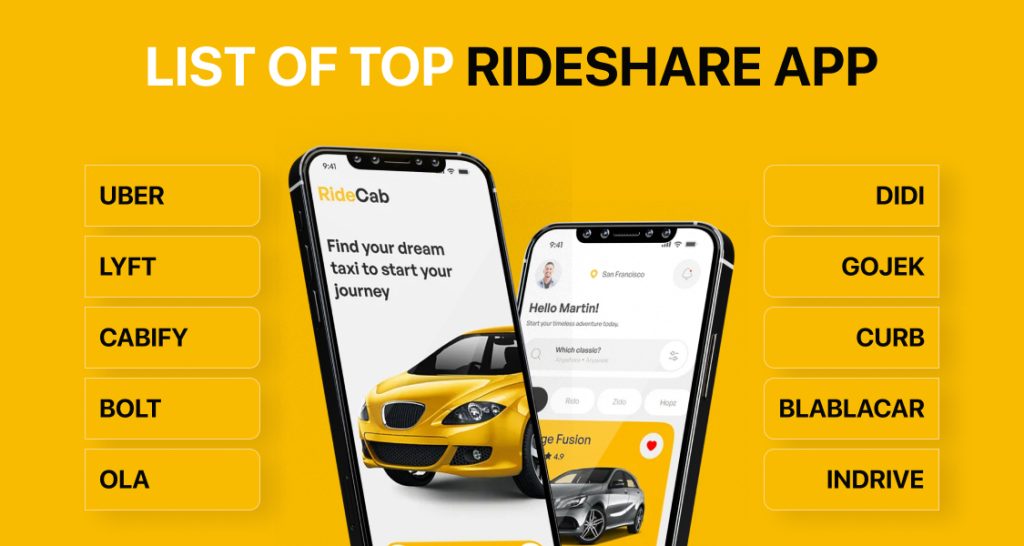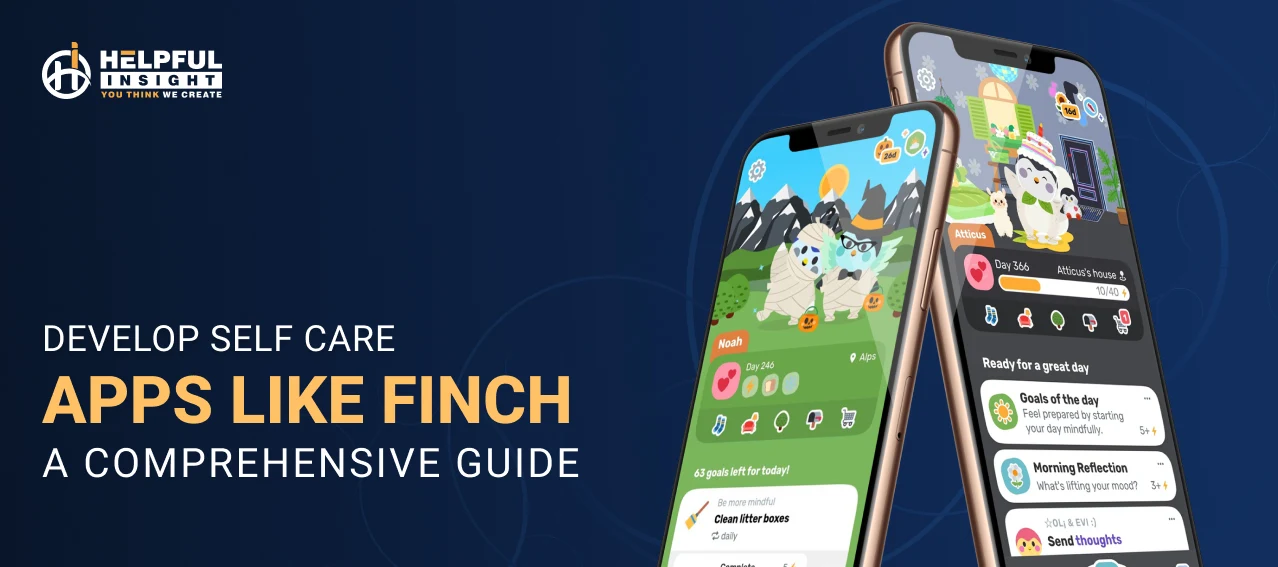“Stay ahead of the curve with top rideshare apps revolutionizing transportation in 2025 with Innovation!”
Uber brought the notion of ridesharing around the world, which took off and made a huge wave in the industry. These apps do a lot more than just offer user convenience; they are eco-friendly, time-saving, save traffic congestion, and save a lot of maintenance costs for the vehicle. It is amazing to witness major ride-sharing platforms like Uber and Lyft have made a place in the hearts of users and become the go-to solution for their journeys.
The global ride-sharing market size was USD 106.66 billion in 2023 and is projected to grow from USD 123.08 billion in 2024 to USD 480.09 billion by 2032. With the growing market, it is sure that people love to use these apps for their travels, even you might have taken a ride with some of the best rideshare apps like Drive. There are still many other apps that have left a lasting impact on the market, becoming an inspiration for businesses to launch more apps and leverage benefits from this billion-dollar industry.
Helpful Insight specializes in mobile app development solutions, but our major area of competence is AI development services. It makes us the ideal partner for those looking for high-end ride-sharing app development that will stand out in a competitive market. Until then, here we present the list of some of the best rideshare application you can explore in 2025. But before diving into them, let’s first go through some basics to get a better understanding of ridesharing apps.
How is The Growth of Ride Sharing Apps Changing The World Of Transportation?
The rise in popularity of ride-sharing applications has revolutionized the worldwide transportation industry by facilitating more accessible, affordable, and enjoyable travel. With the use of smart technology, these apps have upended public transportation systems and traditional taxi services by giving users instant access to on-demand mobility.
If you are considering the idea of building a ride-hailing app, you should first evaluate the service’s current market performance. We’ve compiled a list of states where ride-hailing applications are becoming increasingly popular.
With every passing day, the amount of revenue generated by ride-sharing apps is increasing. According to Statista, the revenue in this market is expected to reach US$175.73 by the end of the year 2025.
The market has a high development potential due to a number of variables, including cost-effectiveness. In terms of numbers, the Ride-hailing market is expected to see a significant increase, with the number of users projected to reach 2.31bn users by 2029.
Amidst a promising market response, the creation of ride-hailing applications has emerged as a profitable investment in building a future-proof firm with long-term possibilities. Creating a mobile app is the most effective technique to provide easy and efficient cab booking services to your target customers.
The Chinese market is the largest market for carpooling apps worldwide, with an estimated US$63.87bn generated in 2025. This figure is expected to increase at an annual growth rate of 6.48%, resulting in a projected market volume of US$82.09bn by 2029. In the ride-hailing sector, the United States is currently the largest economy by far.
What Are The Types Of Ride-Sharing Apps?
If you are thinking about developing a ride-sharing app, we advise you to learn about the different types of ride-sharing apps because it will help you to understand the ride-sharing apps will help you understand which type of app is ideal for your business.
1. Taxi Aggregator Apps
Passengers can request rides through this on-demand service, and car owners can accept or reject reservations based on their convenience. The route sharing and destination are different for drivers and passengers. In this case, the passengers will search for the driver and pay them for the particular trip.
2. Peer-to-Peer Ridesharing
Peer-to-peer ridesharing apps allow passengers to hire a car from their owners for a short time. In this type of ride-sharing app, the passengers are also the drivers. People would rather rent a car for such purposes because they dislike taking public transit.
3. Carpooling Apps
Users tip drivers and divide the cost of transportation evenly while using carpooling mobile apps. By acting as a mediator between drivers and passengers, the software enables users to continue traveling with a driver who is heading in the same direction and then split the cost of transportation, gas, and other costs equally.
Read Also: Cost to Build An Advanced Driver Assistance System Like Tesla Autopilot
List of Top 10 Rideshare Apps in 2025

The car-pooling app market is now more competitive as a result of more people looking at ridesharing mobile applications. Even though there has been more competition among car-sharing apps lately, just a few top applications have managed to establish themselves as industry leaders in both the domestic and foreign markets.
When you’re prepared to launch your ridesharing app, Helpful Insight’s skilled ride-sharing app developers can turn your vision into a full-fledged app. Here we present you a list of the top 10 ridesharing apps to explore in 2025. Let’s check them out:
| Sr.no | Rideshare Apps | Founding Year | Country Of Origin | Rating | Downloads | Revenue |
| 1. | Uber | 2009 | USA | 4.7 | 500M+ | $ 31.8 billion |
| 2. | Lyft | 2012 | USA | 4 | 50M+ | $ 4.1 billion |
| 3. | Cabify | 2011 | Spain | 3.9 | 10M+ | $ 683.8million |
| 4. | Bolt | 2013 | Estonia | 4.7 | 50M+ | $ 23 Million |
| 5. | Ola | 2010 | India | 4-.1 | 100M+ | 5 Billion |
| 6. | DiDi | 2012 | China | 4.2 | 50M+ | $ 20.37 billion |
| 7. | GoJek | 2010 | Indonesia | 4.2 | 10Cr+ | 14.79 trillion |
| 8. | Curb | 2007 | USA | 2.9 | 1M+ | $ 21.4 million |
| 9. | BlaBlaCar | 2006 | France | 4.3 | 50M+ | $ 85.7 million |
| 10. | inDrive | 2012 | Russia | 4.6 | 100M+ | $10 million |
#1. Uber: The Global Leader in Ride-Sharing and On-Demand Transportation
Founded in 2009, in San Francisco, California, Uber Technologies is an American multinational transportation company that specializes in ride-sharing services but also offers other services like food delivery, courier services, ride-hailing, and freight transportation. With more than 150 million monthly active customers and 6 million active drivers and couriers, it is one of the biggest and most well-known ridesharing services in the world. They provide services in 70 countries and 10,500 cities around the globe. Many ride-sharing app development companies study Uber’s success to make their app as amazing as theirs.
- Website: Visit Uber
- Ratings: 4.5 stars
- Downloads: 50 Cr+
#2. Lyft: Revolutionizing Ride-Sharing with a People-First Approach
Lyft, Inc. is an American company that was launched on June 9, 2012, that provides motorized scooters, bicycle sharing systems, and ride-hailing services in the US and a few Canadian cities. There are several ways to get there with the Lyft app, whether you’re rushing to run errands, going out for the evening, commuting to the office, or catching a flight. Lyft gives users complete control over their schedule, can drive whenever it suits them, and can be their boss. All of your tips are yours to keep, and you may cash out at any time you want. The ride-sharing app developers from a reputable development firm can help you create an app as impactful as Lyft.
- Website: Visit Lyft
- Ratings: 4.5 stars
- Downloads: 5Cr+
#3. Cabify: Spain’s Premier Ride-Sharing App Revolutionizing Urban Mobility
Cabify is a platform that makes it easier to transport both individuals and products. Cabify is your transportation and mobility app, whether you want to send your belongings from one part of the city to another, schedule a private auto ride, or take a taxi throughout the city. And without sacrificing the most crucial component: the safety and quality of your travels. Currently, this ride-sharing software offers services in eight countries, allowing you to go by taxi or automobile. Use this top taxi-service providing app to hire a cab driver in various cities and begin taking advantage of additional transportation alternatives, such as motorbike delivery, airport taxis, and automobile rides.
- Website: Visit Cabify
- Ratings: 4.5 stars
- Downloads: 50L+
#4. Bolt: Europe’s Leading Ride-Sharing Platforms
Founded in Tallinn, Estonia, in 2013, Bolt is a mobility firm that provides carsharing, food and grocery delivery (through the Bolt Food app), ride-hailing and micro-mobility rentals. With over 3 million drivers and courier partners, the corporation boasts over 150 million consumers. With the help of our in-app emergency Assist button, users of the Bolt may instantly and discreetly notify an emergency response team. This alerts their committed safety team as well, and they will promptly contact us for assistance.
- Website: Visit Bolt
- Ratings: 4.8 Star
- Downloads: 10 Cr+
#5. Ola: Rideshare & Car Rentals
Ola, which was founded on December 3, 2010, is the largest ride-hailing service in India and one of the largest in the world, serving over 250 cities in Australia, New Zealand, India, and the United Kingdom. The Ola app connects consumers with drivers and a range of vehicles, such as motorcycles, autorickshaws, metered taxis, and taxis, to solve mobility issues for hundreds of millions of customers and over 1.5 million driver-partners. Ola ride-sharing service provider company announced in April 2024 that it was withdrawing from all international markets to focus on the Indian market. In August 2024, the company changed its name to Ola Consumer.
- Website: Visit Ola
- Ranking: 4.7 Star
- Downloads: 10Cr+
#6. DiDi: The World’s Leading Mobility Technology Platform
DiDi Global Inc. is a leading mobility technology platform that provides drivers, delivery partners, and vehicle owners with a variety of flexible learning options. With more than 550 million customers globally, DiDi offers more than just ride-hailing; it also offers banking solutions, food delivery, and a variety of mobility alternatives. The business offers app-based services such as intra-city freight, designated driving, car, and energy solutions, and shared mobility choices like Hitch, and it operates in Asia Pacific, Latin America, and other international markets. DiDi keeps influencing the direction of on-demand services and urban mobility through innovation and technology.
- Website: Visit DiDi
- Ranking: 3.9 Start
- Downloads: 10Cr+
#7. GoJek: Going Beyond Rideshare
Established on 5 Oct 2010, Gojek is one of the top on-demand platforms in Southeast Asia and a pioneer of the multi-service ecosystem model, offering a variety of services such as logistics, food delivery, and transportation. In 2009, Gojek was first founded in Indonesia as a call center to link customers to two-wheeled ride-hailing and courier delivery businesses. With a current valuation of USD 10 billion, Gojek has evolved into a super app that offers over 20 services to help millions of users with daily necessities, business, news, entertainment, transportation and logistics, food and shopping, and payments.
- Website: Visit GoJek
- Ranking: 4.2 Stars
- Downloads: 10Cr+
#8. Curb – Best Rideshare App for Long-Distance
The Curb taxi app was made available in 65 US cities in 2016, including Miami, New York City, Boston, Philadelphia, Chicago, Los Angeles, San Francisco, Las Vegas, and Washington, DC. Customers can order transportation and make purchases using contactless payments. Curb, which is now accessible everywhere, links to more than 100,000 drivers in practically every major American city. To get where you’re going, you can take a cab, a wheelchair-accessible car, or the recently introduced Select* option. Simply select your destination to get Upfront Pricing for every automobile option.
- Website: Visit Curb
- Ranking: 3.3 Stars
- Downloads: 10L+
9. BlaBlaCar: Long-Distance Carpooling App with Safety and Affordability
Leading the way in long-distance carpooling worldwide, BlaBlaCar provides a cost-effective and environmentally responsible substitute for conventional transport. It ensures cost-sharing and lowers carbon footprints by matching drivers with empty seats with passengers traveling in the same direction. BlaBlaCar prioritizes safety and offers a secure booking system, user ratings, and verified profiles. With operations in more than 22 nations, it has transformed intercity travel by increasing the accessibility and dependability of shared rides.
- Website: Visit BlaBlaCar
- Rating: 4.6 Stars
- Downloads: 10Cr+
#10. inDrive: Empowering Riders with Fair-Priced, Fast, and Negotiable Rides
InDrive is a distinctive ride-hailing app platform that guarantees fair pricing and transparency by enabling fare negotiation between drivers and riders. InDrive promotes a more driver-friendly income model by giving customers more flexibility and control over their travels than traditional ridesharing apps. The app, which operates in more than 45 countries, is a well-liked option for millions of people looking for economical and effective transportation options because it provides quick, dependable, and economical urban and intercity travel.
- Website: Visit inDrive
- Rating: 4.7 Stars
- Downloads: 10cr+
Best Ride Share Apps Trends You Should Consider
Ride-sharing applications are expanding quickly and getting more competitive. For businesses to succeed in the fiercely competitive market, they must incorporate distinctive traits. The various trends you should be aware of to remain competitive are listed here:
1. Geolocation
This is among the greatest features that every program for carpooling ought to offer. Numerous functions in the application are dependent on geolocation data to function. Geolocation can help the app do all of these tasks accurately, whether it’s determining the quickest way to go to the rider’s pickup and destination location or locating a ride-sharing partner.
2. Artificial Intelligence (AI)
Ridesharing applications like Uber are not left behind as the AI revolution permeates every industry. These apps use artificial intelligence (AI) to generate precise driving routes, which can save users money and cut down on their commuting hours. It is also feasible to offer consumers a customized experience by incorporating AI into the system and gathering data about their actions.
3. Anomaly Detection
One of the most significant issues facing the globe today is safety. Uber and other industry titans are therefore taking several actions to ensure people’s safety. if the driver deviates from the intended path, stops for extended periods, or finishes the trip somewhere else. Consequently, the app instantly notifies the driver and the rider to make sure everything is alright.
4. Machine Learning
Ever ponder how Uber finds compatible rides and pairs them with the same taxi to maximize the efficiency of its ridesharing system? The Uber ridesharing app is powered on machine learning algorithms. That is significantly less sophisticated than the use of machine learning technologies in ride-sharing apps like Uber.
Lyft, a well-known online taxi booking service, also use machine learning to comprehend customer history in order to optimize routes, assess driver availability, and provide affordable rates. When it comes to developing rideshare applications, machine learning technology has virtually endless potential. You may therefore make your application more user-centric by adhering to these trends.
5. Electric Vehicles
Most of the top ride-sharing applications, including Uber and Lyft, are about to switch to electric cars in order to give its users more ecologically friendly and sustainable transportation choices.
Now that you’re considering developing a ridesharing mobile application, you should not overlook the significance of assembling an electric car fleet to maintain your competitiveness in the emerging mobility market. Now that you’re considering developing a ridesharing mobile application, you should not overlook the significance of assembling an electric car fleet to maintain your competitiveness
Read Also:-What you should know about developing a Ride-Sharing App in 2025: The Definitive Guide
What Is The Cost Of Developing A Rideshare App Like Uber?
It is difficult to pinpoint the cost of developing a ride-sharing app like Uber or Lyft. The cost differs depending on various factors, including the features you integrate, the app complexity, the platform you choose, the developers’ expertise, the location of the development team, and more. But to give you a general idea, the ride-sharing app development cost can lie anywhere between $40,000 to $300,000.
| Type of App | Cost Estimation | Time Duration |
| Basic | $40,000 to $60,000 | 2 to 3 Months |
| Intermediate | $60,000 to $90,000 | 3 to 6 Months |
| Advanced | $90,000 to $300,000 | 9+ Months |
How Does Helpful Insight Help With Ridesharing App Development?
Because of the rising popularity and demand for ridesharing services, some taxi companies have responded by releasing taxi apps. One of the top developers of ride-sharing apps is Helpful Insight. We can be the greatest option for you if you’re searching for a premium ride-sharing app created by professionals. Thousands of apps have been created and designed by us. We help our clients grow their businesses by providing them with successful mobile app development services.
With a decade of expertise in building top-quality apps, Helpful Insight has made a name for itself in the IT industry. We can give our clients a solution that allows them to proceed by combining technology with client-centric innovation. Being well-versed in the creation of automotive and transportation solutions enables us to establish a great reputation among clients. Contact our experts to discuss your idea, and stay tuned for informative updates.
FAQs
Ans. Safety is a top priority for rideshare companies. Features include:
- Real-time GPS tracking: Friends and family can track your ride in real time.
- Emergency button: Directly contacts local emergency services in case of danger.
- Driver background checks: Comprehensive screenings, including criminal records.
- Rating and review systems: Drivers and passengers can rate each other to maintain service quality.
- Facial recognition & OTP verification: Ensures drivers and riders match the assigned trip.
Ans. Rideshare applications have created millions of flexible job opportunities worldwide. Drivers can set their schedules, allowing them to work full-time or part-time based on their availability. In addition to drivers, these platforms support employment in areas like customer support, app development, and logistics. However, challenges such as driver earnings, lack of benefits, and competition from autonomous vehicles are shaping the future of the gig economy.
Ans. The rideshare industry is evolving rapidly, with several trends shaping its future:
- Autonomous Vehicles: Companies like Uber and DiDi are investing in self-driving technology, aiming to replace human drivers in the coming years.
- AI & Smart Route Optimization: Artificial intelligence will improve ride efficiency, reducing wait times and fuel consumption.
- EV Expansion: More cities will transition to fully electric rideshare fleets for sustainable transportation.
- Decentralized & Peer-to-Peer Ridesharing: Blockchain and decentralized networks might introduce new business models where riders can connect directly with drivers, bypassing traditional platforms.
- Super Apps: Companies like Gojek and Careem are leading the way in developing all-in-one platforms that combine ride-hailing, food delivery, financial services, and more.
Ans. Most rideshare apps offer multiple payment methods to enhance user convenience. Common payment options include:
- Credit/Debit Cards: Visa, Mastercard, American Express, and more.
- Digital Wallets: Google Pay, Apple Pay, PayPal, and in-app wallets.
- Cash Payments: Available in some regions like India and Latin America.
- Cryptocurrency: A few apps like inDrive are experimenting with crypto payments.
Having varied payment options makes rideshare services accessible to people who may not have credit cards or prefer digital payments.












